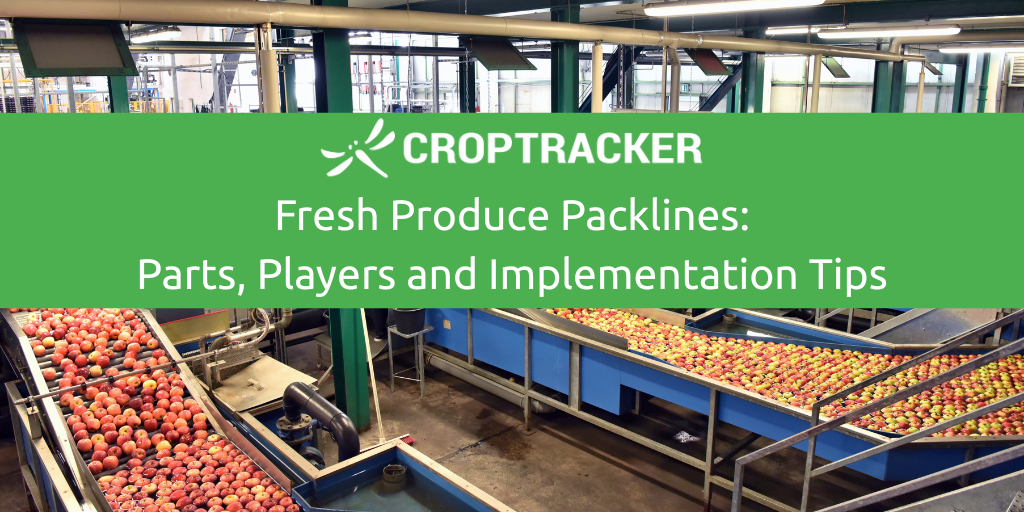At Croptracker, we work with customers to help optimize their produce packing for traceability, improved logistics and sales and this often involves working with ‘packlines’. In the fresh produce industry, a 'packline' is a dedicated facility or system where harvested fruits and vegetables are processed, sorted, and packed for distribution to consumers.
Packing is a critical step that occurs after the product is picked from the field and before it is shipped to markets, grocery stores, or restaurants. However, not all packing operations are equal, in fact, most are pretty unique and custom built. In this article we take a look at the main components of a produce packline, who are the major players in the industry and explore some of the things to consider when considering implementing or updating a packline.
A typical packline includes a series of machinery and stations designed to clean, grade by size and quality, and then place the produce into appropriate packaging. The primary goal of a packline is to ensure that the produce is handled efficiently, meets quality standards, and is presented in a way that is attractive to buyers and ready for sale. The packline operation can be a significant investment, involving conveyor belts, washing systems, optical sorters, and automated bagging or boxing machines.
For smaller farms and producers, owning and operating a full-scale packline is often not economically feasible due to the high costs of equipment, labor, and maintenance. Instead, many smaller growers utilize shared or third-party packinghouses. These facilities, sometimes referred to as 'custom packing' operations, provide a service to multiple farms, allowing them to benefit from modern packing technology without the prohibitive capital expenditure.
In this model, the smaller farm still harvests their crop, but they transport it to the packinghouse to be processed. The packinghouse charges a fee for their services, which can be based on a per-box or per-pound rate. This arrangement allows small producers to focus on what they do best—growing high-quality produce—while ensuring their products are packed to the standards required by today's competitive marketplace. The ownership of the produce remains with the farmer until it is sold, but the packinghouse handles the final preparation and often the logistics of shipping as well. This collaborative model is vital for the viability and growth of small-scale agriculture.
Even for small/mid sized growers who do not own their own packline, it is beneficial to understand how they work, as they generally dictate grower pay outs. Choosing a custom packing operation to send your fruit to can be informed by what kind of line they use; how old it is? and is how the data from it is shared with you?
For larger growers considering implementing or upgrading a packline, having a long term vision and plan for implementation is key to success. Packline plans should include how to communicate the features and benefits of your custom packing operation to outside small growers. Knowing the intricacies of your line is essential for this communication.
Main components of a fresh produce packline
A typical packline includes a series of machinery and stations designed to clean, grade by size and quality, and then place the produce into appropriate packaging. An automated packline is a sophisticated system that transforms bulk fruit from the orchard into packaged, market-ready products.
The primary goal of a packline is to ensure that the produce is handled efficiently, meets quality standards, and is presented in a way that is attractive to buyers and ready for sale. The packline operation can be a significant investment, involving conveyor belts, washing systems, optical sorters, and automated bagging or boxing machines. It is a carefully choreographed sequence of machinery and processes, typically including:
- Infeed and handling: The process begins with the gentle introduction of fruit from bulk harvest bins onto the line. This is often done by submerging the bins in water, allowing the fruit to float out to a conveyor belt, a method that helps to remove debris and prevent bruising.
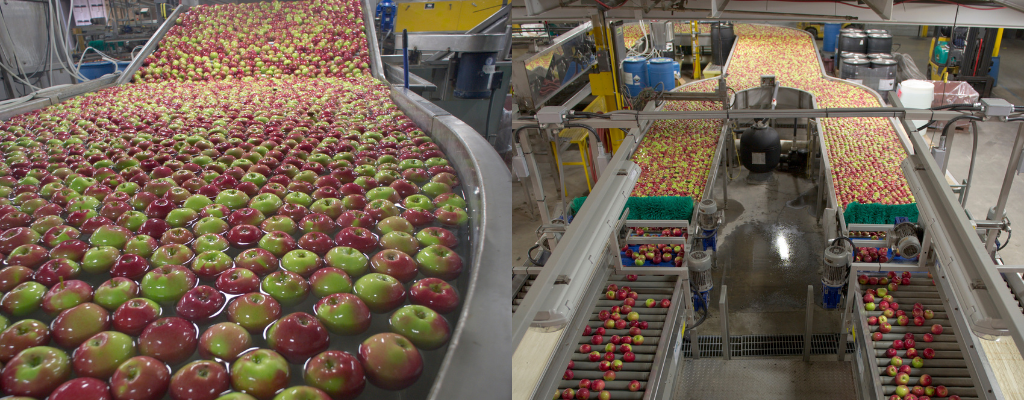
Apple packline infeed
Photos courtesy of Farm & Foodcare Ontario - Pre-sorting and cleaning: After the infeed, the fruits or vegetables are moved to cleaning and rinsing stations. They are washed with food-grade detergents and disinfectants, rinsed, and then air-dried. This stage can also involve a pre-sorting step where trained personnel or early-stage technology remove visibly damaged, decayed, or undersized fruit, known as "culls".
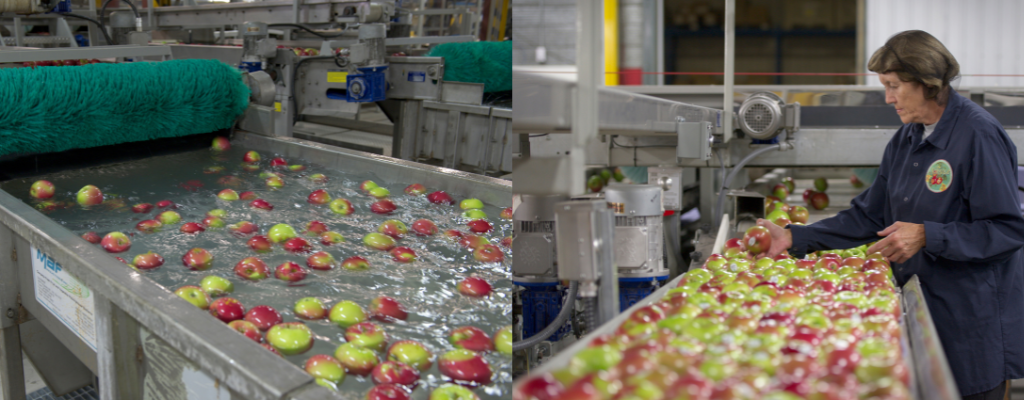
Apple packline cleaning and manual visual presort
Photos courtesy of Farm & Foodcare Ontario - Grading and sizing: This is often considered the "heart" of a packhouse, where the true value-add occurs. Fruits are individually analyzed using advanced optical systems that employ high-resolution cameras and sensors. The technology captures dozens of images of each apple to create a 360-degree digital profile. Based on user-defined parameters, the fruit is meticulously sorted by a range of characteristics, including size, shape, color, weight, and both internal and external defects.
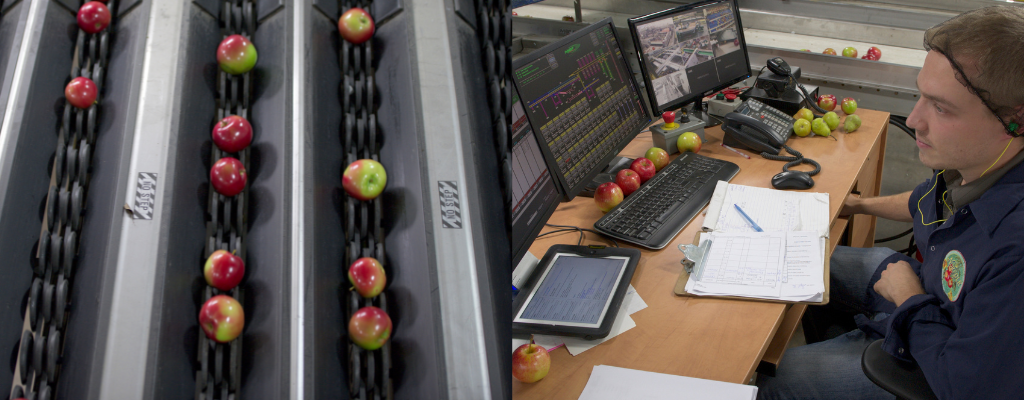
Apple sorting control centre and sorted apple lanes
Photos courtesy of Farm & Foodcare Ontario - Packing: Once graded, the produce is directed to specific packing areas via conveyor belts or water flumes. Here, they are placed into trays or bags, either by hand or by advanced robotic packers. Most lines still use hand packing into trays at the end of the line, however increasingly, robotic systems can handle delicate fruit with variable grip strength and precision, even orienting them in one direction in the tray.
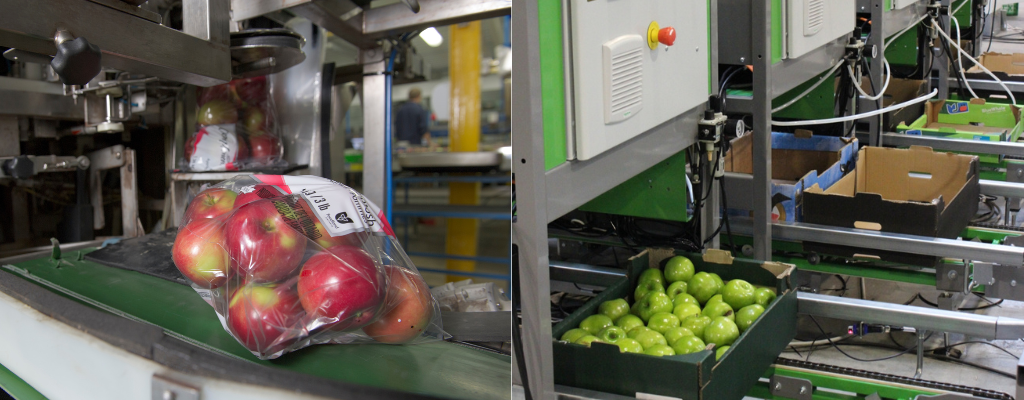
Apple bags and trays being filled at the end of a packline
Photo courtesy of Farm & Foodcare Ontario (left)
Photo courtesy of MAF-RODA Box Filler (right) - End-of-line logistics: This final phase prepares the product for storage and distribution. It includes automatically labeling individual fruits and boxes, weighing cartons, and stacking the finished products onto pallets. Some packlines include machines known as palletizers that help automate this process to reduce manual labor and ensure a high-throughput, efficient end to the line. The entire system is often governed by a single, comprehensive software platform that controls logistics and provides end-to-end traceability.
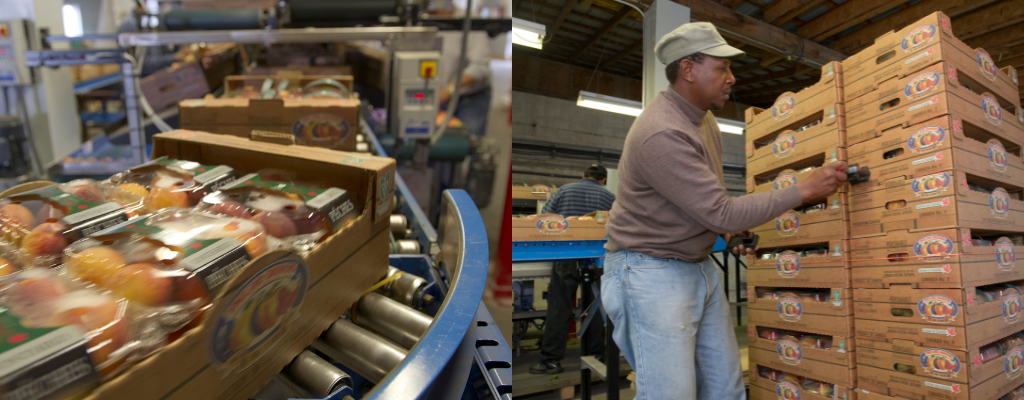
Packed peaches being moved off a packline and onto a pallet
Photos courtesy of Farm & Foodcare Ontario
Challenges of implementation
While packing automation offers significant benefits, the process of implementing a new, or upgraded, packline comes with a distinct set of challenges:
- (very) High upfront costs: A fully automated packline represents a significant capital investment. The initial cost of equipment, installation, and software can be a major barrier, particularly for small-to-medium-sized operations. Grants, co-ownership or grower co-op investments are often necessary to finance a new line.
- Integration with existing systems: Many packhouses have existing machinery from different manufacturers and technological generations. A major hurdle is seamlessly integrating new, state-of-the-art equipment with legacy systems. Differences in communication protocols or production speeds can lead to bottlenecks and a temporary dip in efficiency.
- Maintenance and support: Automated systems are complex and require specialized knowledge to maintain. Finding and retaining trained technicians can be difficult, and a lack of local support or access to spare parts can lead to costly downtime if a breakdown occurs.
- The human element: Introducing new technology can be met with resistance from a workforce accustomed to manual processes. The transition requires significant investment in training and communication to ensure employees are prepared and comfortable with the new systems.
- Physical and infrastructural limitations: Packhouses require a reliable and abundant supply of water and electricity, and a new facility needs to be built on a flat site with adequate space. Some packlines are larger than a football field and cannot be out in the elements. Without sound infrastructure, a new line cannot operate efficiently, no matter how advanced it is.
- Cost vs. sustainability: There is increasing pressure to use eco-friendly packaging, but these materials are often more expensive and can struggle with the high-moisture environments of a packline. Striking a balance between a package's ability to maintain food safety and its environmental impact can be challenging and costly.
Major packline manufacturers
Below we have highlighted a few of the biggest players in the fresh produce packline industry. If you are in the market for a packline or have worked with more than one custom packer before, these are likely familiar. Each company has a wide range of offerings and all sales will require consultation and some customization. We have briefly summarized their main features and supported fresh produce crop types.

TOMRA offers a variety of optical sorting, grading, and packing machines for fruits. Their technologies include the Spectrim and InVision² with LUCAi™ for AI-powered sorting, the Inspectra² for internal quality grading using near-infrared spectroscopy, and various sorters and fillers like the TOMRA 5B, TOMRA 5S Advanced, and Gentle Box Filler.
- Supported Fresh Fruit / Vegetables: Apples, Avocados, Bell Peppers, Berries, Blueberries, Broccoli, Cauliflower, Cherries, Citrus, Corn, Garlic, Green Beans, Kiwifruit, Leafy Greens, Mangoes, Mushrooms, Olives, Onions, Peas, Peppers, Pickles/Cucumbers, Pineapples, Potatoes, Radishes, Stone Fruit, and Tomatoes

UNITEC builds sorting, grading, and packing machinery for many types of fruits and vegetables. Their technology uses dedicated sorters for each type of produce, focusing on gentle handling. The sorting systems assess both external (color, skin defects) and internal (firmness, brix degrees, ripeness) quality. The company emphasizes that its technology is "100% Made in Unitec." reassuring that they design and produce all core components in-house. This is a confidence booster for this large investment as it means the company can supply trusted and specific replacement parts and troubleshooting.
- Supported Fresh Fruit / Vegetables: Apples, Avocados, Blueberries, Cherries, Citrus, Cucumbers, Eggplants, Kiwifruit, Melons, Pears, Peppers, Persimmons, Pomegranates, Stone Fruit, Tomatoes, Watermelons, and Zucchini

GREEFA provides user-friendly sorting and packing solutions for a variety of fruits and vegetables. With a history spanning 75 years, Greefa is a well-established provider of fruit-sorting solutions. Their product line includes grading machines like the GeoSort and SmartSort, as well as measuring systems for quality, weight, size, and color. They also offer peripherals, internal logistics, and data analysis systems. GREEFA's solutions are designed with a modular approach, allowing customers to customize their systems.
- Supported Fresh Fruit / Vegetables: Apples, Citrus, Cucumbers, Eggplants, Kiwis, Mangoes, Pears, Peppers, Stone Fruit,Tomatoes, and Zucchini

AWETA offers turnkey solutions for grading and packing fresh produce. With over 55 years of experience, they provide customized solutions for a wide range of produce, including apples, avocados, and tomatoes. The company is known for its expertise in scanning produce and automating sorting and packing equipment, continuously innovating to meet market demands.
- Supported Fresh Fruit / Vegetables: Apples, Avocados, Citrus, Cucumbers, Kiwis, Mangoes, Pears, Peppers, Stonefruit, and Tomatoes. They also offer tailor-made solutions for produce not on this list

MAF RODA specializes in providing global "turnkey conveyor lines" for the grading, electronic sorting, and packaging of fresh fruits and vegetables. They offer custom post-harvest solutions and have an extensive international presence with subsidiaries and agents to provide local expertise and after-sales service.
- Supported Fresh Fruit / Vegetables: Apples, Bulbs, Broccoli, Carrots, Cherries, Citrus, Cucumbers, Grapes, Kiwis, Mangoes, Melons, Pears, Peppers, Potatoes, Strawberries and Stone Fruit
For a producer planning a new, large-scale facility from the ground up, engaging with a turnkey provider like Aweta or MAF RODA AGROBOTIC would be a logical choice. Their end-to-end solutions simplify the procurement process and ensure a high degree of integration from a single vendor
Conversely, for a smaller-scale operation or an existing facility needing an upgrade, companies with a modular or component-based model, such as Greefa or Wyma Solutions, provide greater flexibility and lower initial investment costs. Their ability to sell individual units allows for phased expansion and the integration of new technologies into existing lines without a full-scale replacement.
No single packline provider offers a solution that is universally superior. The best choice depends on the specific needs of the packer.

Tips to consider before choosing a packline
To navigate implementing or updating a packline successfully, it is important to take a strategic and long-term approach:
- Develop a long-term plan: Before making any decisions on equipment, it is crucial to create a detailed plan that forecasts fruit volumes, varieties, and market demand for the next 15-20 years. This will help you decide on the right capacity for your packline.
- Conduct a prior audit: Thoroughly assess your existing infrastructure to identify potential compatibility issues with new equipment. Work with suppliers who can offer customized or modular solutions that fit your specific needs and can be expanded over time.
- Choose a partner, not a vendor: The relationship with your packline manufacturer should be a long-term partnership built on trust. Choose a company that provides comprehensive after-sales support, ongoing training, and a strong local presence for maintenance and spare parts.
- Involve your staff early: Engage your employees from the beginning of the project. Clearly communicate the benefits of the new technology—such as reduced repetitive tasks and new professional development opportunities—to foster buy-in and a smoother transition.
- Secure your infrastructure: Ensure your site has a reliable and secure source of electricity and water. Consider investing in backup generators or alternative energy sources like solar to prevent costly downtime during the critical packing season.
- Think about the data: It is important to understand how the packline reporting and information can be organized and integrated into your inventory, sales and grower payment systems. Do you have other farm management softwares that needs to integrate pack line information or feed information to your packline? Will your packline provide information to justify grower payments? Consult with your other service providers to see what data integrations are possible.
Optimizing your packline for success
Whether you're a small grower sending your fruit to a custom packinghouse or a large producer planning a new facility, understanding the intricacies of a packline is key. The right setup can improve efficiency, ensure quality, and increase the value of your produce. By carefully considering your long-term goals, choosing the right partners, and focusing on seamless integration, you can build a packing operation that not only meets the demands of today’s market but also sets you up for future growth and profitability.
